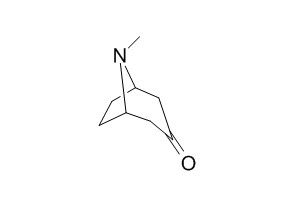Tropinone
Tropinone is a decane alkaloid, used as an intermediate in the synthesis of atropine sulfate.
Inquire / Order:
manager@chemfaces.com
Technical Inquiries:
service@chemfaces.com
Tel:
+86-27-84237783
Fax:
+86-27-84254680
Address:
1 Building, No. 83, CheCheng Rd., Wuhan Economic and Technological Development Zone, Wuhan, Hubei 430056, PRC
Providing storage is as stated on the product vial and the vial is kept tightly sealed, the product can be stored for up to
24 months(2-8C).
Wherever possible, you should prepare and use solutions on the same day. However, if you need to make up stock solutions in advance, we recommend that you store the solution as aliquots in tightly sealed vials at -20C. Generally, these will be useable for up to two weeks. Before use, and prior to opening the vial we recommend that you allow your product to equilibrate to room temperature for at least 1 hour.
Need more advice on solubility, usage and handling? Please email to: service@chemfaces.com
The packaging of the product may have turned upside down during transportation, resulting in the natural compounds adhering to the neck or cap of the vial. take the vial out of its packaging and gently shake to let the compounds fall to the bottom of the vial. for liquid products, centrifuge at 200-500 RPM to gather the liquid at the bottom of the vial. try to avoid loss or contamination during handling.
J Ginseng Res.2022, 46(1):104-114.
J Ethnopharmacol.2018, 210:88-94
Front Chem.2022, 10:1048467.
J Ginseng Res.2020, 44(4):611-618.
Korean J of Medicinal Crop Science2018, 220-226
J Chromatogr A.2024, 1714:464544.
Molecules.2020, 25(7):1625.
Nutrients2022, 14(3),695.
Food Sci Biotechnol.2024, 33(15):3629-3637.
Nutrients.2020, 12(12):3607.
Related and Featured Products
Bioorg Chem. 2014 Apr;53:37-49.
Substrate flexibility and reaction specificity of tropinone reductase-like short-chain dehydrogenases.[Pubmed:
24583623]
Annotations of protein or gene sequences from large scale sequencing projects are based on protein size, characteristic binding motifs, and conserved catalytic amino acids, but biochemical functions are often uncertain.
METHODS AND RESULTS:
In the large family of short-chain dehydrogenases/reductases (SDRs), functional predictions often fail. Putative Tropinone reductases, named Tropinone reductase-like (TRL), are SDRs annotated in many genomes of organisms that do not contain tropane alkaloids. SDRs in vitro often accept several substrates complicating functional assignments. Cochlearia officinalis, a Brassicaceae, contains tropane alkaloids, in contrast to the closely related Arabidopsis thaliana. TRLs from Arabidopsis and the Tropinone reductase isolated from Cochlearia (CoTR) were investigated for their catalytic capacity. In contrast to CoTR, none of the Arabidopsis TRLs reduced Tropinone in vitro. NAD(H) and NADP(H) preferences were relaxed in two TRLs, and protein homology models revealed flexibility of amino acid residues in the active site allowing binding of both cofactors. TRLs reduced various carbonyl compounds, among them terpene ketones. The reduction was stereospecific for most of TRLs investigated, and the corresponding terpene alcohol oxidation was stereoselective. Carbonyl compounds that were identified to serve as substrates were applied for modeling pharmacophores of each TRL. A database of commercially available compounds was screened using the pharmacophores. Compounds identified as potential substrates were confirmed by turnover in vitro.
CONCLUSIONS:
Thus pharmacophores may contribute to better predictability of biochemical functions of SDR enzymes.
J Org Chem. 2014 Dec 5;79(23):11609-18.
A twist on facial selectivity of hydride reductions of cyclic ketones: twist-boat conformers in cyclohexanone, piperidone, and tropinone reactions.[Pubmed:
25372509]
The role of twist-boat conformers of cyclohexanones in hydride reductions was explored.
METHODS AND RESULTS:
The hydride reductions of a cis-2,6-disubstituted N-acylpiperidone, an N-acylTropinone, and tert-butylcyclohexanone by lithium aluminum hydride and by a bulky borohydride reagent were investigated computationally and compared to experiment. Our results indicate that in certain cases, factors such as substrate conformation, nucleophile bulkiness, and remote steric features can affect stereoselectivity in ways that are difficult to predict by the general Felkin-Anh model. In particular, we have calculated that a twist-boat conformation is relevant to the reactivity and facial selectivity of hydride reduction of cis-2,6-disubstituted N-acylpiperidones with a small hydride reagent (LiAlH4) but not with a bulky hydride (lithium triisopropylborohydride).
Chem Commun (Camb). 2013 Nov 28;49(92):10775-7.
Robinson's landmark synthesis of tropinone.[Pubmed:
24116374]
The 1917 total synthesis of Tropinone by Sir Robert Robinson represents a landmark achievement in organic synthesis. Decades ahead of its time in terms of its retrosynthetic logic and biomimetic approach, the elegant combination of these two elements in this synthesis continues to serve as an inspiration for the development of new and efficient strategies for complex molecule synthesis.



